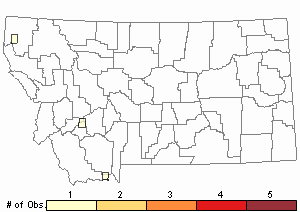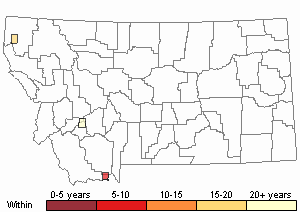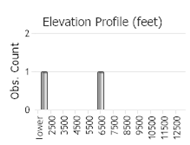View in other NatureServe Network Field Guides
NatureServe
Montana
Utah
Wyoming
Idaho
Wisconsin
British Columbia
South Carolina
Yukon
California
New York
Western Sedge - Carex occidentalis
State Rank Reason (see State Rank above)
Carex occidentalis occurs on the northern edge of its range in Beaverhead County, Montana. This sedge is known from four locations of which specimens found at sites in 2018 and 1996 have been verified. The 1895 specimen is imprecisely mapped in Silver Bow County and may no longer be present and the 1984 report needs to be verified. Threats have not been identified and this species can be easily overlooked. Surveys that bring forth current data on locations, population sizes, habitat requirements, or threats is greatly needed.
- Details on Status Ranking and Review
Population Size
ScoreU - Unknown
CommentUnknown.
Range Extent
ScoreE - 5,000-20,000 sq km (~2,000-8,000 sq mi)
Comment12,514 square kilometers which is likely an over-estimate.
Area of Occupancy
ScoreC - 3-5 4-km2 grid cells
CommentMontana can be divided into 30,390 4x4 square kilometer cells. For this species plant observations occur in 4 of these 4x4 square kilometer cells.
Number of Populations
ScoreA - 1 - 5
Comment4 occurrences though one is likely extirpated and another needs to be verified.
Threats
CommentNo identified threats though livestock grazing occurs at one of the locations.
General Description
PLANTS: Western Sedge has short, creeping rhizomes (not conspicuous) and forms dense bunches with flowering stems that are sharply triangular and up to 80 cm tall. Source: (Ball in FNA 2002).
LEAVES: Blades are flat with slightly inrolled margins, 1.5 to 2.5(-3) mm wide. Sheaths are tight, green, and hyaline in the front. Ligules are less than 2mm long and as long wide. Sources: (Ball in FNA 2002; Hurd et al. 1998).
INFLORESCENCE: 4-10 spikes are tightly clustered towards the top, but more spaced towards the bottom. Each spike is oblong, 15-35 mm long by 6-10 mm. Spikes are androgynous with inconspicuous male flowers at the top. There are two stigmas. Sources: (Ball in FNA 2002; Hurd et al. 1998).
Phenology
Flowering and fruiting in June-July (Ball in FNA 2002).
Diagnostic Characteristics
Carex is a large genus, making individual species identification difficult at times. The bunch-forming growth form, elongate heads and elliptic perigynia are among the more diagnostic characteristics of this species among upland Carex. Mature fruit and a technical key are essential in order to separate this from closely related species.
Species Range
Montana Range
Range Descriptions

 Native
Native
Range Comments
Beaverhead and Madison Counties east to SD, south to CA and TX; most common in CO, UT AZ and NM (FNA 2002).
Observations in Montana Natural Heritage Program Database
Number of Observations: 3
(Click on the following maps and charts to see full sized version)
Map Help and Descriptions
Relative Density

Recency



 (Observations spanning multiple months or years are excluded from time charts)
(Observations spanning multiple months or years are excluded from time charts)
Habitat
Western Sedge is occasionally to frequently found in dry grasslands and forests, generally at mid-elevations, but extending upward to sulalpine or alpine areas from 1,200 to 3,500 meters in elevation Sources: (Ball in FNA 2002; Hurd et al. 1998).
National Vegetation Classification System Groups Associated with this Species
Shrubland
Sagebrush Shrubland
Wetland and Riparian
Riparian Shrubland
Reproductive Characteristics
Spikes have inconspicuous male flowers at the top (androgynous).
Perigynia are green to straw-colored, but become brown at maturity and 2.5-4.5 mm long and 1.5-1.9 mm wide. They are smooth and shiny and are loosely ascending or spreading in the spikes. Their shape is oblong-elliptic and plano-convex. Their margins are sparingly serrulate above the middle, yet sharp, narrow, green, smooth, and shiny. The base of the body is somewhat spongy. Nerves are inconsipicuous or absent.
Beaks are abruptly narrowed from the body, serrulate, flat, shallowly to deeply bidentate, and 0.2-1.2 mm long.
Achene is oblong-orbicular, lenticular, light-brown at maturity, 1.3-2.4 mm long, and 0.9-1.5 mm wide.
Stigmas 2.
Stewardship Responsibility
Threats or Limiting Factors
STATE THREAT SCORE REASON
Threat impact not assigned because threats are not known (MTNHP Threat Assessment 2021).
References
- Literature Cited AboveLegend:
 View Online Publication
View Online Publication Flora of North America Editorial Committee(FNA). 2002. Flora of North America north of Mexico. Vol. 23. Magnoliophyta: Commelinidae (in part): Cyperaceae. Oxford Univ. Press, New York. xxiv + 608 pp.
Flora of North America Editorial Committee(FNA). 2002. Flora of North America north of Mexico. Vol. 23. Magnoliophyta: Commelinidae (in part): Cyperaceae. Oxford Univ. Press, New York. xxiv + 608 pp. Hurd, E.G., N.L. Shaw, J. Mastrogiuseppe, L.C. Smithman, and S. Goodrich. 1998. Field Guide to Intermountain Sedges. General Technical Report RMS-GTR-10. Ogden, UT: U.S. Department of Agriculture, Forest Service, Rocky Mountain Research Station. 282 pp.
Hurd, E.G., N.L. Shaw, J. Mastrogiuseppe, L.C. Smithman, and S. Goodrich. 1998. Field Guide to Intermountain Sedges. General Technical Report RMS-GTR-10. Ogden, UT: U.S. Department of Agriculture, Forest Service, Rocky Mountain Research Station. 282 pp. MTNHP Threat Assessment. 2021. State Threat Score Assignment and Assessment of Reported Threats from 2006 to 2021 for State-listed Vascular Plants. Botany Program, Montana Natural Heritage Program, Helena, Montana.
MTNHP Threat Assessment. 2021. State Threat Score Assignment and Assessment of Reported Threats from 2006 to 2021 for State-listed Vascular Plants. Botany Program, Montana Natural Heritage Program, Helena, Montana.
- Web Search Engines for Articles on "Western Sedge"





